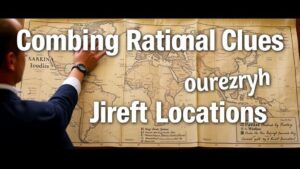Techniques for Finding Hidden Numerical Keys in Lengthy Treasure Texts
Techniques for Finding Hidden Numerical Keys in Lengthy Treasure Texts
Deciphering treasure texts can often feel like solving a complex puzzle, where hidden numerical keys provide the vital clues needed to unlock the mysteries of location or item retrieval. The practice calls for a combination of analytical skills and creative thinking, as these keys are typically embedded within extensive narratives or multilinear texts. This article aims to explore several techniques designed to effectively find these hidden keys, enhancing both enthusiasm and efficacy in treasure hunting.
Understanding the Structure of Treasure Texts
Before delving into the methods for uncovering numerical keys, its crucial to grasp how treasure texts are often constructed. Most texts follow a narrative structure that includes:
- Introduction of characters or elements central to the treasure’s story
- Descriptive passages that may conceal actual instructions
- A climax that typically contains the most crucial clues
- Resolution, which may provide contextual numbers or locations
Many treasure texts utilize conventional formats or symbolic language, making familiarity with the structure a necessary first step in the extraction of numerical keys.
Pattern Recognition Techniques
Pattern recognition plays a pivotal role when navigating lengthy texts. By isolating recurring numerical sequences, words, or phrases, hunter-readers can often infer the presence of a hidden key. For example, a passage may reference three gold coins and seven dark crows, which could signify coordinates or the sum of a significant number. Employing tools such as frequency analysis can help highlight anomalies or repetitions in the text.
A classic case is the famous Beale Ciphers, where numerical keys were cleverly woven into plaintext through repetition and paralleling historical events, leading to the discovery of treasure locations.
Mathematical Approaches to Key Extraction
Another effective method involves applying mathematical techniques to the text. This could mean converting letters to numbers based on their position in the alphabet or recognizing patterns in sequences that suggest mathematical operations. For example, using a simple A=1, B=2 scheme, one can evaluate if certain phrases correspond to known numerical values linked to maps or geographical features.
Take the case of the Dighton Rock inscriptions, where researchers employed mathematical modeling to correlate text inscriptions with regional geographical coordinates, ultimately producing a working reference to locate historical sites.
Linguistic Analysis
Some numerical keys can be embedded within the syntax or semantics of the text. Analyzing the parts of speech or the semantic roles can unearth implications that lead to numbers. For example, an analysis of adjectives describing quantity or measurements may reveal coded messages leading to the numerical keys. Certain phrases like half a mile or a quarter of a pound may suggest half or quarters as actual value triggers for further decoding.
A practical example of linguistic extraction occurred in the famous Treasure of Oak Island, where wordplay was used to create riddles that pointed towards numerical geographical features critical to finding treasure.
Use of Technological Aids
In todays digital age, there are myriad tools available to assist treasure hunters. Text analysis software can process lengthy texts and help identify patterns, frequencies, and hidden keys. Optical character recognition (OCR) combined with machine learning may also allow for deeper analysis of old or handwritten documents, uncovering numerical clues that might be lost in the original formatting.
For example, in the field of historical document analysis, researchers have effectively utilized AI algorithms to sift through voluminous archives, pinpointing numerical codes hidden within mountains of irrelevant text.
Case Studies: Real-World Applications
The techniques discussed have real-world applications evidenced by remarkable case studies. A noteworthy example is the City of Gold legend in South America, where explorers utilized pattern recognition and linguistic clues from local myths to hone in on elusive numerical coordinates leading them closer to the treasures location.
Also, the pioneering use of mathematical models in interpreting key historical manuscripts has yielded significant findings in archaeology, providing the foundations for claims regarding hidden treasures that were once deemed lost.
Actionable Takeaways
For aspiring treasure hunters, employing the aforementioned techniques can dramatically enhance the potential for finding hidden numerical keys within lengthy treasure texts. Key practices include:
- Familiarizing oneself with the structure of the text
- Useing pattern recognition strategies
- Utilizing mathematical and linguistic analysis
- Leveraging technological tools
By integrating these techniques systematically, one can significantly improve the chances of decrypting those elusive numerical keys, opening the door to potential treasures waiting to be discovered.



